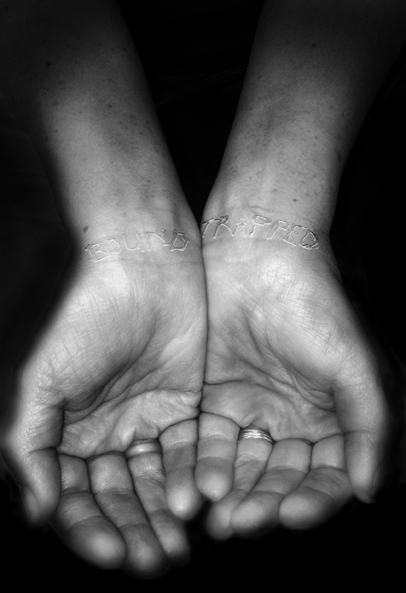Self-harm, help to heal
By Rachel England
Self-harm is a hugely misunderstood behaviour which is often used as a coping mechanism.

Recovery is an emotionally challenging journey, but, as Rachel England finds, it’s within every sufferer’s reach.
Who does self-harm affect?
The topic of self-harm has grown in the public consciousness over the last few years as the media increasingly reports on the practice in young people, or more specifically, teenage girls. But self-harm is a non-discriminating behaviour which can be observed in all sectors of society, and as Hannah Winslow’s account shows this behaviour is not confined to the adolescent. The secretive nature of self-harm means it’s almost impossible to get realistic figures, which only contributes to the stigma commonly attached to it.
What is self-harm?
While our case study Hannah’s self-harm took the form of cutting, any action designed to inflict pain on the body can be classed as self-harming behaviour. Examples include:
• cutting, scratching
• burning
• biting
• hair pulling, hair cutting
• punching, hitting, whipping yourself
• punching objects
• purposeful self-neglect
• substance abuse, poisoning.
Why do people self-harm?
Contributing factors to self-harm
Feelings induced by self-harm
The psychology of self-harm
Individuals who self-harm are often trapped in unhappy feelings from the past, says chartered counselling psychologist, Martin Wilks. “Thoughts and imagery can recreate, very clearly, difficult periods in the past – so much so that you can re-experience feelings as if you’re still there,” he says. “In situations like this a sharp pain, in which you deem yourself in control, suddenly snaps you back into the moment. So it’s the past memories that need to be examined in order to change the behaviour.”
Similarly, individuals using self-harm to cope with issues in the present can be unintentionally trapping themselves in a toxic environment. As Martin says, “If you’re using self-harm to deal with domestic abuse, for example, you’re actually creating a support system which allows you to go on tolerating the trigger of the self-harm. In this case, the immediate circumstances need to be addressed to allow recovery to take place”.
It’s a destructive cycle. Feelings of emotional distress lead to carrying out the action of self-harm, which creates a sense of shame, which then exacerbates the emotional distress, and so on. Because of the misconception that self-harm is a teenage issue, adults often feel that they should have a higher degree of emotional maturity and should be able to deal with their problems, which can worsen their feelings of failure and low self-worth.
Misconceptions
Misconceptions about the behaviour are rife, and wholly unhelpful when it comes to addressing the problem. Reports by the BBC indicate that 41 per cent of those surveyed believe self-harm is ‘selfish’, and 55 per cent think it’s ‘stupid’. As Martin says, “There’s a common belief that self-harm is about manipulating others, that it’s used to get the individual out of things they might not want to do, or to gain special treatment. But that’s just not the case at all”.
These faulty beliefs surrounding self-harm can make it very difficult for sufferers to seek help, which is a daunting step anyway, as for many it means relinquishing a coping mechanism that they’ve come to depend on. As Eva says, “It’s very important that the decision to stop comes from the person who is self-harming, and even then, stopping or reducing self-harm can be a long and slow process. People need the opportunity to build up their coping skills gradually”.
Steps to break the cycle
Therapy for self-harm doesn’t have the objective of simply making the behaviour stop though; it examines the triggers and motives behind it and aims to equip the sufferer with an ability to better regulate their feelings. It’s important that the sufferer feels completely safe and able to talk freely, and to feel that what they’re doing is understandable – but it’s also important that the negative aspects of self-harm are reinforced, as many sufferers have come to rely on it, and can therefore view it as a supportive, positive behaviour.
The most important factor during recovery though, Martin claims, is self-acceptance. “For a lot of mental health issues, the difficulty is being embattled by your inner experiences; taking up arms against your thoughts and feelings and thinking, ‘What’s wrong with me?’ And paradoxically, once you’ve defined it as a problem that has to be gotten rid of, the very effort to get rid of it becomes the problem itself. Until you can drop the agenda of being at war with your inner experience, it’s very difficult to drop the coping mechanism.”
It’s self-acceptance, according to Martin, that can help those who self-harm ‘leave the battleground’. “If individuals learn to be around their thoughts and feelings and make room for them, instead of fighting them, they can find a place from which to reflect on their emotions, and gradually their coping ability increases and the self-harm gradually diminishes. But that has to be a by-product of therapy, not a principal objective, because if it’s the main focus then you’re just back to the old agenda of ‘getting rid’. You can’t get rid of your history, or emotions. You can just make peace with them.”
Further help
Self-harm top tips on breaking the cycle
Adult self-harm a real-life story
What is self-harm? A brief overview
Self-injury an intimate blog post
Blake Fielder Civil - Life after Amy Winehouse, recovery from drugs and self harm
External help
Borderline Personality Disorder help
We hope you have found this information useful, please also see
What is Borderline Personality Disorder
Borderline Personality Disorder Symptoms
Borderline Personality Disorder Treatments
Living with Borderline Personality Disorder
Real Life: Borderline Personality Disorder
Borderline Personality Disorder - Basic Facts from SANE
A tribute to tragic suicide victim Louise Wright
Family of Borderline Personality Disorder suicide victim speak out





